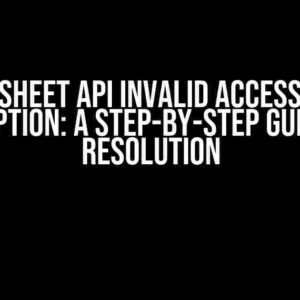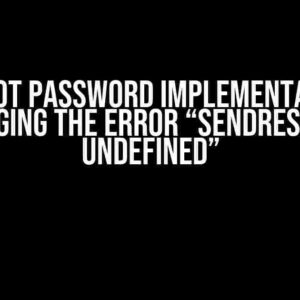Are you tired of Raygun interfering with your application’s performance? Do you want to know the secret to disabling it completely after loading? Look no further! In this comprehensive guide, we’ll take you through the step-by-step process of disabling Raygun, ensuring your application runs smoothly and efficiently.
What is Raygun?
Raygun is a popular error tracking and monitoring tool used by developers to identify and troubleshoot issues in their applications. While it’s an excellent tool for debugging, it can sometimes slow down your application or interfere with its performance.
Why Disable Raygun?
There are several reasons why you might want to disable Raygun completely after loading:
-
Performance Optimization: Raygun can consume system resources, slowing down your application. Disabling it can improve performance and responsiveness.
-
Security Concerns: Raygun collects error data, which can be sensitive information. Disabling it can help protect your application from potential security breaches.
-
Customization: You might want to disable Raygun to implement custom error tracking and monitoring solutions tailored to your application’s specific needs.
Disabling Raygun Completely After Loading
Now that we’ve established the reasons for disabling Raygun, let’s dive into the step-by-step process:
-
window.Raygun-disable(): This is the simplest way to disable Raygun. You can add this code snippet to your application’s JavaScript file, preferably in the footer or after the Raygun script has loaded. -
window.Raygun-provider.destroy(): This method is more aggressive and destroys the Raygun provider instance, ensuring it’s completely disabled. -
window.Raygun-disableAll(): This method disables all Raygun features, including error tracking, user tracking, and custom data.
<script> // Disable Raygun after loading window.Raygun-disable(); // Destroy Raygun provider instance window.Raygun-provider.destroy(); // Disable all Raygun features window.Raygun-disableAll(); </script>
| Method | Description |
|---|---|
| window.Raygun-disable() | Disables Raygun error tracking and monitoring |
| window.Raygun-provider.destroy() | Destroys the Raygun provider instance, disabling all features |
| window.Raygun-disableAll() | Disables all Raygun features, including error tracking, user tracking, and custom data |
Best Practices for Disabling Raygun
To ensure a smooth experience, follow these best practices when disabling Raygun:
-
Test Thoroughly: Verify that your application functions as expected after disabling Raygun.
-
Monitor Performance: Keep an eye on your application’s performance and adjust the disabling method accordingly.
-
Customize Wisely: If you’re implementing a custom error tracking solution, ensure it’s optimized for your application’s specific needs.
Frequently Asked Questions
We’ve got answers to some common questions you might have:
| Q | A |
|---|---|
| Will disabling Raygun affect my application’s functionality? | No, disabling Raygun won’t affect your application’s functionality. However, you might lose error tracking and monitoring capabilities. |
| Can I re-enable Raygun later? | Yes, you can re-enable Raygun by removing the disabling code or using the window.Raygun-enable() method. |
| What if I’m using a Raygun wrapper or library? | Consult the wrapper or library’s documentation for specific disabling instructions, as they might differ from the standard methods. |
Conclusion
Mastering Raygun is just a few lines of code away! By following this comprehensive guide, you’ll be able to disable Raygun completely after loading, optimizing your application’s performance and security. Remember to test thoroughly, monitor performance, and customize wisely. Happy coding!
If you have any further questions or need more information on Raygun, feel free to ask in the comments below.
Frequently Asked Questions
Get the scoop on disabling the raygun feature after loading – we’ve got the answers you need!
Why do I need to disable the raygun completely after loading?
Disabling the raygun completely after loading is essential to prevent any accidental fires or misuse. You wouldn’t want to risk causing harm to yourself or others, would you? So, make sure to disable it once you’re done loading!
How do I disable the raygun completely after loading?
Easy peasy! To disable the raygun, simply locate the safety switch and flip it to the “off” position. You might also need to remove the energy source or power down the device, depending on the type of raygun you’re using. Refer to your user manual for specific instructions.
What happens if I don’t disable the raygun completely after loading?
Oh no! If you fail to disable the raygun, you’re risking a world of trouble. Accidental discharges, injuries, or even damage to property could occur. Don’t take the risk – make sure to disable that raygun completely after loading!
Can I just put the raygun on standby instead of disabling it completely?
Sorry, buddy! Standby mode isn’t good enough. You need to disable the raygun completely to ensure total safety. Think of it like putting a car in park – you wouldn’t leave the engine running, right? Same principle applies here.
What if I’m in a hurry and don’t have time to disable the raygun?
Hold up, hotshot! Safety always comes first. Disabling the raygun might take an extra minute, but it’s worth it to avoid any potential risks. Remember, it’s better to be safe than sorry – or in this case, blasted to smithereens!



